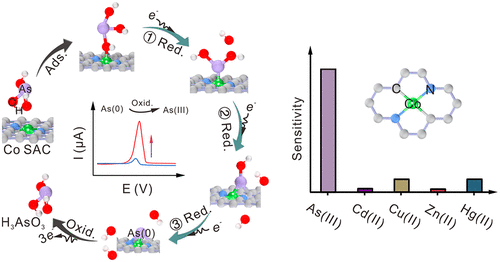当前位置:
X-MOL 学术
›
Anal. Chem.
›
论文详情
Our official English website, www.x-mol.net, welcomes your
feedback! (Note: you will need to create a separate account there.)
Ultra-Sensitive and Selective Detection of Arsenic(III) via Electroanalysis over Cobalt Single-Atom Catalysts.
Analytical Chemistry ( IF 6.7 ) Pub Date : 2020-04-01 , DOI: 10.1021/acs.analchem.0c00677 Pei-Hua Li 1, 2 , Meng Yang 1 , Yi-Xiang Li 1 , Zong-Yin Song 1 , Jin-Huai Liu 1 , Chu-Hong Lin 1 , Jie Zeng 2 , Xing-Jiu Huang 1
Analytical Chemistry ( IF 6.7 ) Pub Date : 2020-04-01 , DOI: 10.1021/acs.analchem.0c00677 Pei-Hua Li 1, 2 , Meng Yang 1 , Yi-Xiang Li 1 , Zong-Yin Song 1 , Jin-Huai Liu 1 , Chu-Hong Lin 1 , Jie Zeng 2 , Xing-Jiu Huang 1
Affiliation

|
Achieving highly sensitive and selective detection of trace-level As(III) and clarifying the underlying mechanism is still a intractable problem. The electroanalysis of As(III) relies on the electrocatalytic ability of the sensing interface. Herein, we first adopt single-atom catalysts as the electrocatalyst in As(III) detection. Cobalt single-atoms anchored on nitrogen-doped carbon material (Co SAC) were found to have an extraordinary sensitivity of 11.44 μA ppb-1 with excellent stability and repeatability, which so far is the highest among non-noble metal nanomaterials. Co SAC also exhibited a superior selectivity toward As(III) compared with some bivalent heavy metal ions (HMIs). Combining X-ray absorption spectroscopy (XAFS), density functional theory (DFT) calculation, and reaction kinetics simulation, we demonstrated that Co single atoms stabilized in N2C2 support serve as active sites to catalyze H3AsO3 reduction via the formation of Co-O hybridization bond, leading to a lower energy barrier, promoting the breakage of As-O bonds. Importantly, the first electron transfer is the rate-limiting step of arsenic reduction and is found to be more favorable on Co-SAC both thermodynamically and kinetically. This work not only expands the potential applicaiton of single-atom catalysts in the detection and treatment of As(III), but also provides atomic-level catalytic insights into HMIs sensing interfaces.
中文翻译:

通过钴单原子催化剂上的电分析超灵敏和选择性地检测砷(III)。
实现痕量As(III)的高灵敏度和选择性检测并弄清其潜在机理仍然是一个棘手的问题。As(III)的电分析依赖于传感界面的电催化能力。在本文中,我们首先采用单原子催化剂作为As(III)检测中的电催化剂。发现固定在氮掺杂碳材料(Co SAC)上的钴单原子具有11.44μAppb-1的非凡灵敏度,具有出色的稳定性和可重复性,是迄今为止在非贵金属纳米材料中最高的。与某些二价重金属离子(HMI)相比,Co SAC对As(III)的选择性也更高。结合X射线吸收光谱(XAFS),密度泛函理论(DFT)计算和反应动力学模拟,我们证明,稳定在N2C2载体中的Co单原子充当活性位点,通过形成Co-O杂化键催化H3AsO3还原,从而导致较低的能垒,从而促进了As-O键的断裂。重要的是,第一次电子转移是砷还原的限速步骤,发现在热力学和动力学上对Co-SAC都更有利。这项工作不仅扩展了单原子催化剂在As(III)的检测和处理中的潜在应用,而且还为HMI传感界面提供了原子级的催化见解。第一次电子转移是砷还原的限速步骤,并且发现在热力学和动力学上对Co-SAC都更有利。这项工作不仅扩展了单原子催化剂在As(III)的检测和处理中的潜在应用,而且还为HMI传感界面提供了原子级的催化见解。第一次电子转移是砷还原的限速步骤,发现在热力学和动力学上对Co-SAC都更有利。这项工作不仅扩展了单原子催化剂在As(III)的检测和处理中的潜在应用,而且还为HMI传感界面提供了原子级的催化见解。
更新日期:2020-04-23
中文翻译:

通过钴单原子催化剂上的电分析超灵敏和选择性地检测砷(III)。
实现痕量As(III)的高灵敏度和选择性检测并弄清其潜在机理仍然是一个棘手的问题。As(III)的电分析依赖于传感界面的电催化能力。在本文中,我们首先采用单原子催化剂作为As(III)检测中的电催化剂。发现固定在氮掺杂碳材料(Co SAC)上的钴单原子具有11.44μAppb-1的非凡灵敏度,具有出色的稳定性和可重复性,是迄今为止在非贵金属纳米材料中最高的。与某些二价重金属离子(HMI)相比,Co SAC对As(III)的选择性也更高。结合X射线吸收光谱(XAFS),密度泛函理论(DFT)计算和反应动力学模拟,我们证明,稳定在N2C2载体中的Co单原子充当活性位点,通过形成Co-O杂化键催化H3AsO3还原,从而导致较低的能垒,从而促进了As-O键的断裂。重要的是,第一次电子转移是砷还原的限速步骤,发现在热力学和动力学上对Co-SAC都更有利。这项工作不仅扩展了单原子催化剂在As(III)的检测和处理中的潜在应用,而且还为HMI传感界面提供了原子级的催化见解。第一次电子转移是砷还原的限速步骤,并且发现在热力学和动力学上对Co-SAC都更有利。这项工作不仅扩展了单原子催化剂在As(III)的检测和处理中的潜在应用,而且还为HMI传感界面提供了原子级的催化见解。第一次电子转移是砷还原的限速步骤,发现在热力学和动力学上对Co-SAC都更有利。这项工作不仅扩展了单原子催化剂在As(III)的检测和处理中的潜在应用,而且还为HMI传感界面提供了原子级的催化见解。











































 京公网安备 11010802027423号
京公网安备 11010802027423号